Simple Sourdough Ciabatta Bread
This post may contain affiliate links. Please read my disclosure policy.
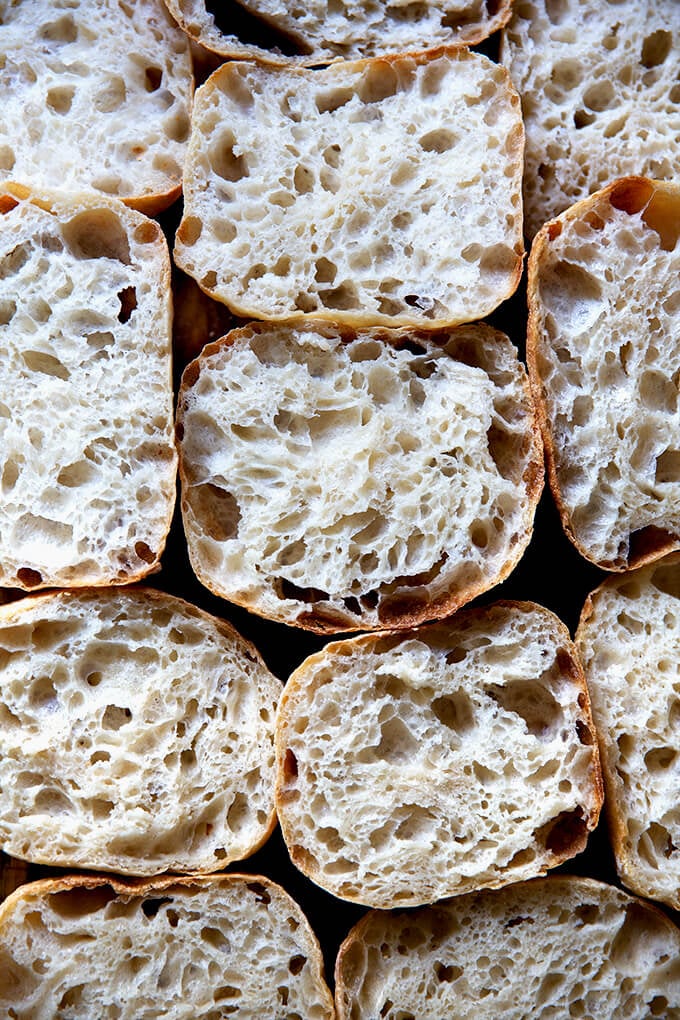
Last month, while posting a photo of this brioche loaf on Instagram, I posed a question: If 2020 was the year of banana bread and focaccia, what will be THE bread of 2021?
Which bread, I asked, did everyone want to learn how to make most?
Of all the responses, which included everything from fougasse to hoagie rolls, a crusty baguette was the most frequently cited, ciabatta following closely behind.
I’m excited to say today, after a few weeks of experiments, I have a wonderful sourdough ciabatta recipe to share. It has a thin, but crisp crust, a beautiful honeycomb crumb, and a lovely lightness and chew. It’s perfect for sandwiches.
And best of all: it’s truly simple. Made with four ingredients, this recipe requires neither an autolyse nor preferment, neither a preheated Dutch oven nor baking stone. If you have a sheet pan, you’re good to go.
What’s more, there’s no shaping or scoring, no balling up dough or creating tension. Truly, after the bulk fermentation, which includes some fridge time, you turn the dough out onto a floured work surface, pat it into a rectangle, and divide it into 8 roughly equal pieces. You then transfer those pieces, irregularly shaped and all, to a sheet pan, and bake them one hour later.
But can I tell you the most exciting part? This dough makes a decent — a more than decent — baguette! It’s not super crusty, but it’s a nice baguette nonetheless, flour-dusted and unscored, with a crumb and flavor better than any other I’ve attempted previously.
Friends, I hope you love this recipe. It’s on par with this sourdough focaccia recipe in terms of simplicity and effort, but it’s a totally different animal. I can’t wait for you to give it a try.
PS: If sourdough isn’t your thing, please try this yeast-leavened ciabatta bread recipe.
This post is organized as follows:
- 3 Tips for Sourdough Success
- What is Ciabatta?
- Sourdough Ciabatta, Step by Step
- Ciabatta Sandwich
- Sourdough Ciabatta “Baguettes” 🥖🥖🥖
3 Tips for Sourdough Success
Before you get started with this recipe, here are my three tips for sourdough bread baking.
- It starts with your starter.
- This will sound obvious, but: it starts with your starter. Before you mix a loaf of sourdough bread, you must ensure your starter is bubbly and active. I like to feed my starter at night before bed, let it rise and fall overnight; then feed it again in the morning. By midday, it’s ready.
- Use a digital scale.
- I say this all the time, but using a scale to measure the ingredients for a loaf of sourdough bread makes all the difference. So much of sourdough bread baking is simply a matter of using the precise amount of water given your environment and given the flour you are using. If you use cups to measure you are simply not being precise, and as a result, you will not be able to make meaningful adjustments should the recipe as written not work out perfectly.
- Use a straight-sided vessel for the bulk fermentation.
- With sourdough bread baking, one frequent problem bakers run into is over-fermentation. If you let the first rise go too long, the dough will over-ferment and become a sticky, unsalvageable mess. A straight-sided vessel allows you to see when your dough has truly increased in volume by 50%, 75%, 100% or whatever volume increase you are after.
- The vessel I use in this recipe, similar to this one, is 8 cups. Most grocery stores carry storage vessels similarly sized.
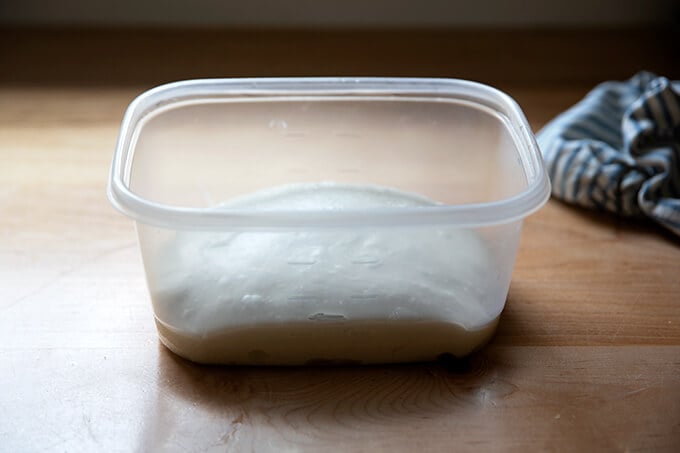
What is Ciabatta?
- Originating from the Lake Como region of northern Italy, ciabatta means “slipper” in Italian. Traditional ciabatta is characterized by this slipper shape as well as an extremely porous and chewy texture.
- Traditionally, ciabatta dough is very wet, calls for very little yeast, and requires a long, slow rise.
- Traditional recipes, too, often call for making a biga (a preferment), which helps produce that light, porous texture.
Sourdough Ciabatta, Step by Step:
Gather your ingredients: bread flour, water, salt, and a sourdough starter. I am a proponent of buying a starter (see recipe box for sources), but if you are up for it, you can build a starter from scratch in just about 1 week.
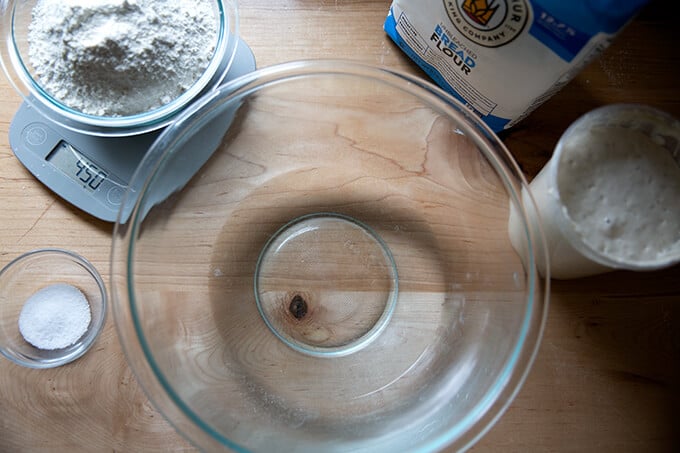
For this recipe, you’ll need: 100 grams sourdough starter, 360 grams water, 450 grams flour, and 12 grams salt. It’s 80% hydration.
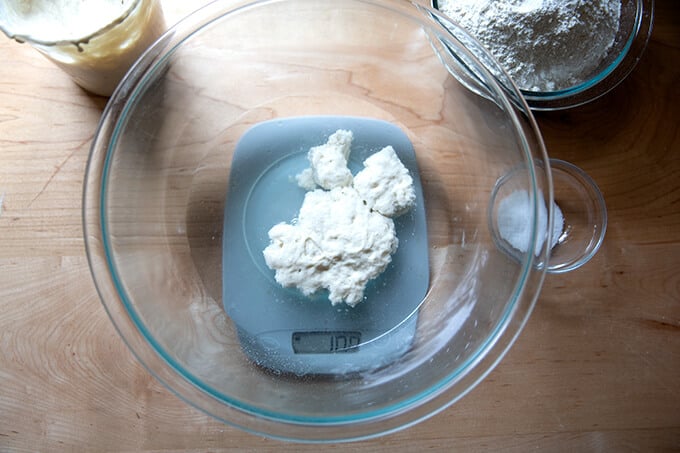
Mix together the water, sourdough starter, and salt.
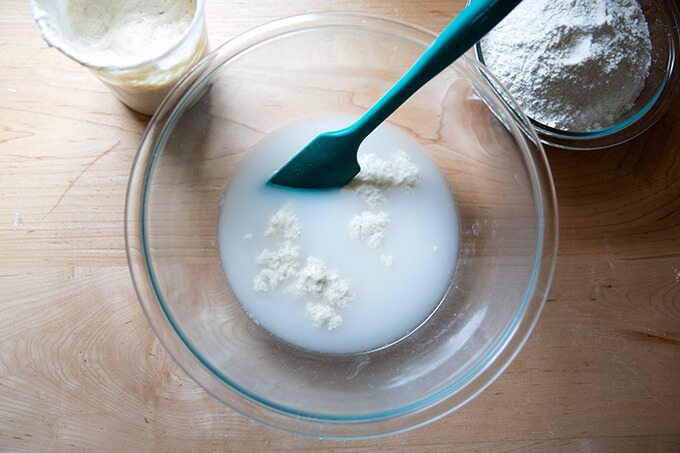
Add the flour and mix to form a sticky dough ball.
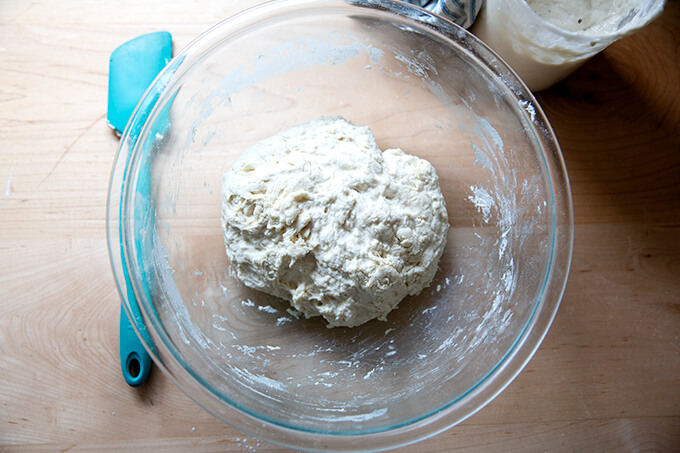
Cover the bowl and let rest for 30 minutes. Then perform a set of stretches and folds. See the video above or in the recipe box for guidance. This is what the dough will look like after one set of stretches and folds.
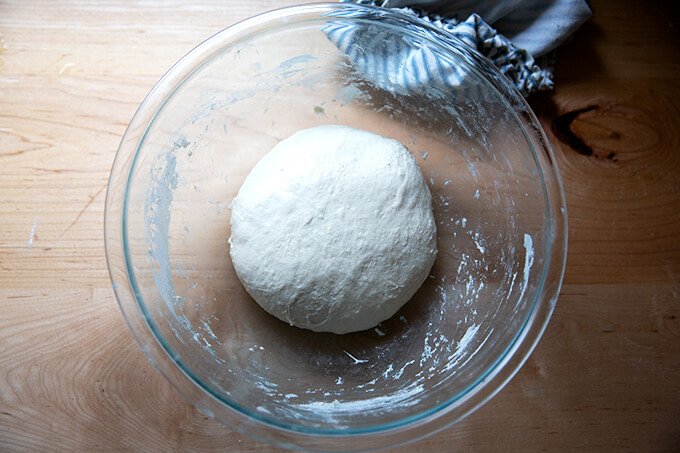
This is what the dough will look like after 4 sets of stretches and folds.
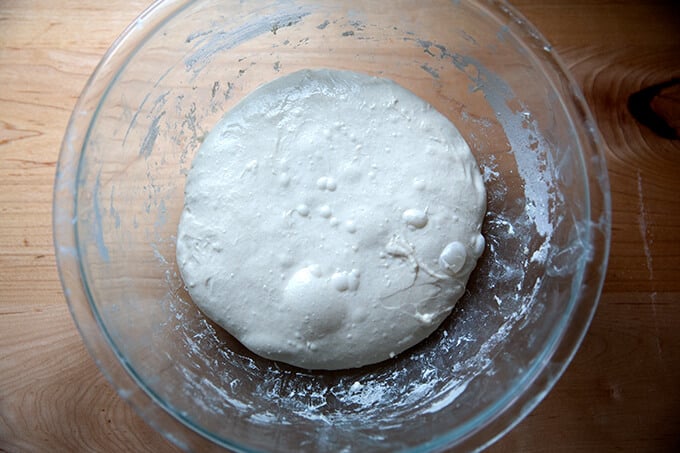
Transfer dough to a straight-sided vessel (this one is 8 cups, but anything similarly sized will do) for the bulk fermentation (the first rise):

Mark the height of the dough on the vessel, cover the vessel, and let the dough rise until it increases in volume by roughly 75%.
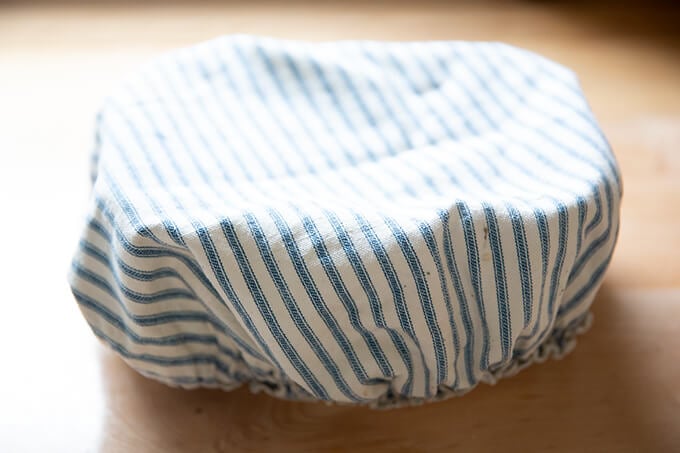
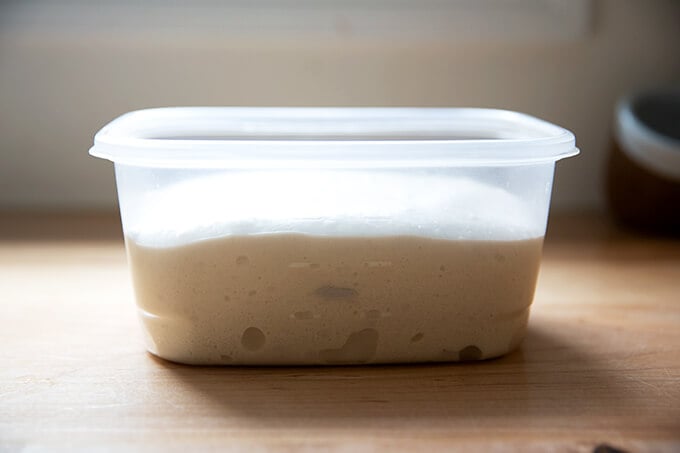
When the dough has increased by 75% (roughly), place a lid on the vessel, and transfer it to the fridge for 12-24 hours.
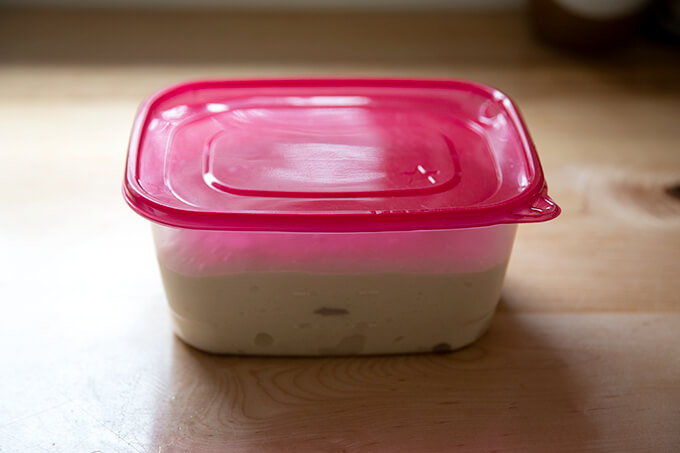
When ready to bake, remove the vessel from the fridge.
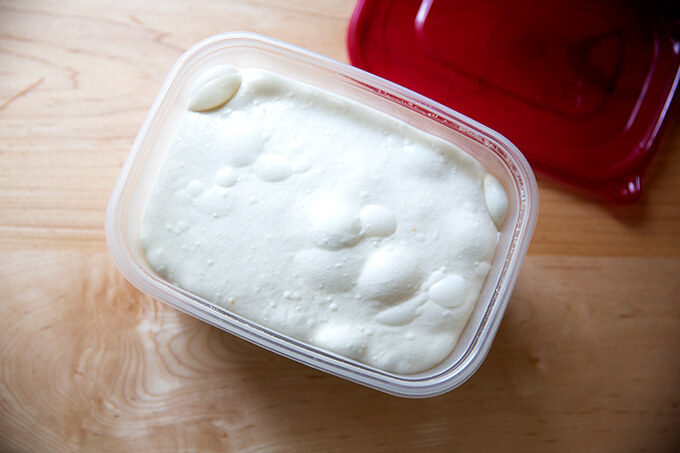
Dust the top of the dough liberally with flour. Dust a work surface liberally with flour, too.
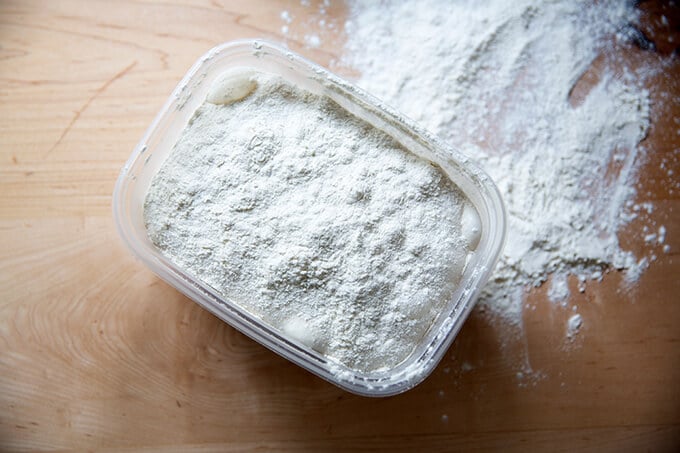
Turn the dough out onto the prepared work surface.
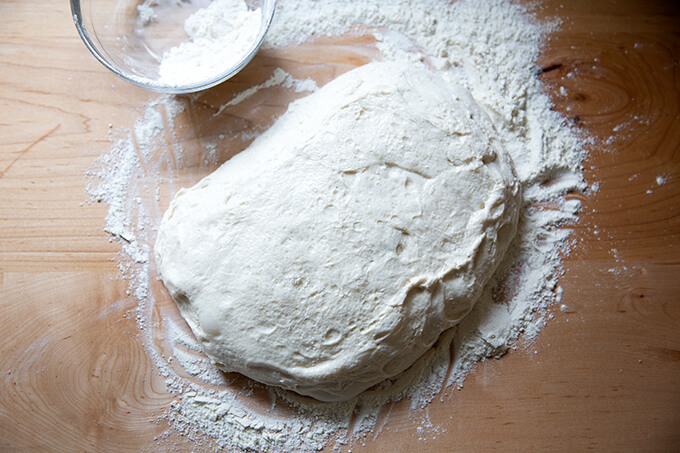
Pat the dough into a rectangle.
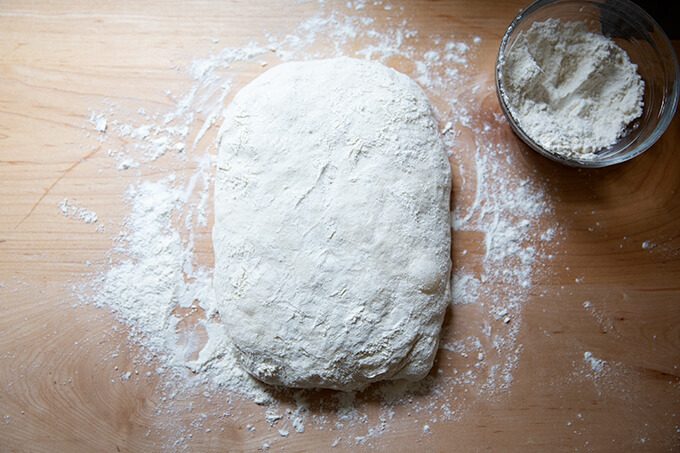
Cut the rectangle into 8 roughly equal portions.
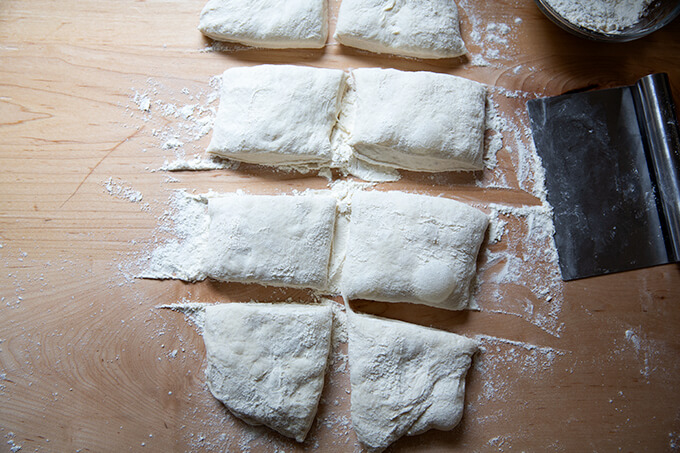
Transfer the portions to a parchment-lined sheet pan. Let rest for 1 hour. Then transfer to a 475ºF oven for 10 minutes. Lower the heat to 450ºF and bake for 10 minutes more.
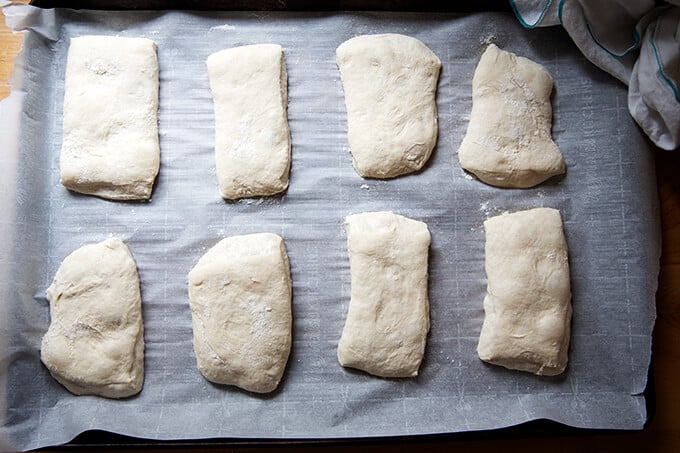
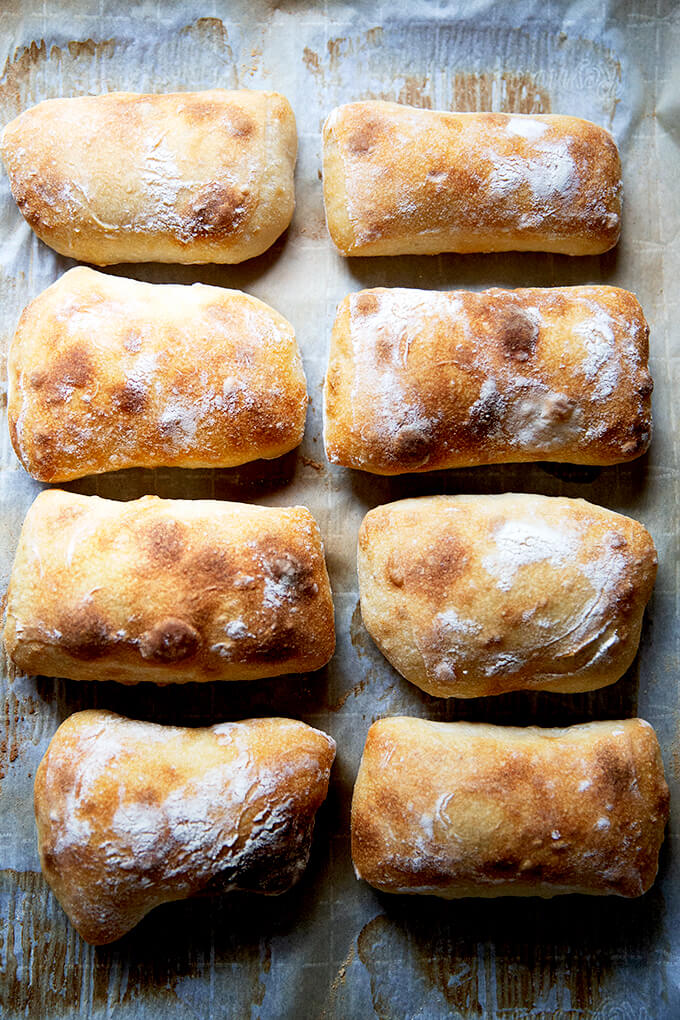
Transfer the rolls immediately to a cooling rack, and let cool for at least 20 minutes before cutting.
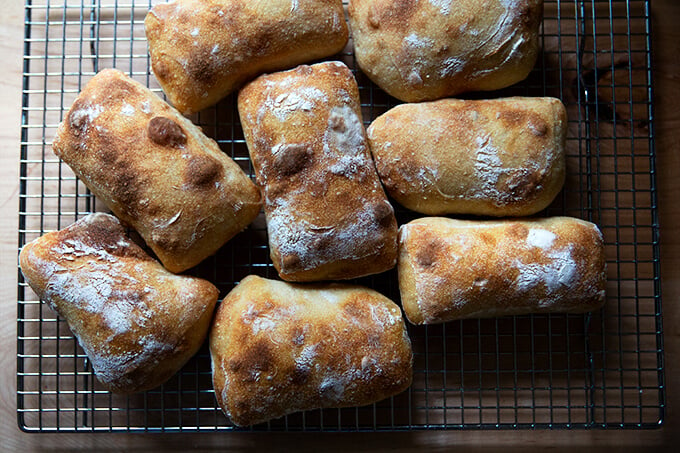
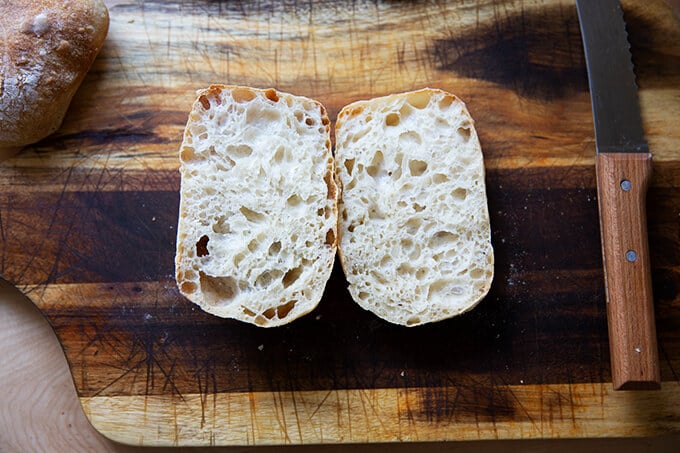
How pretty is that crumb?
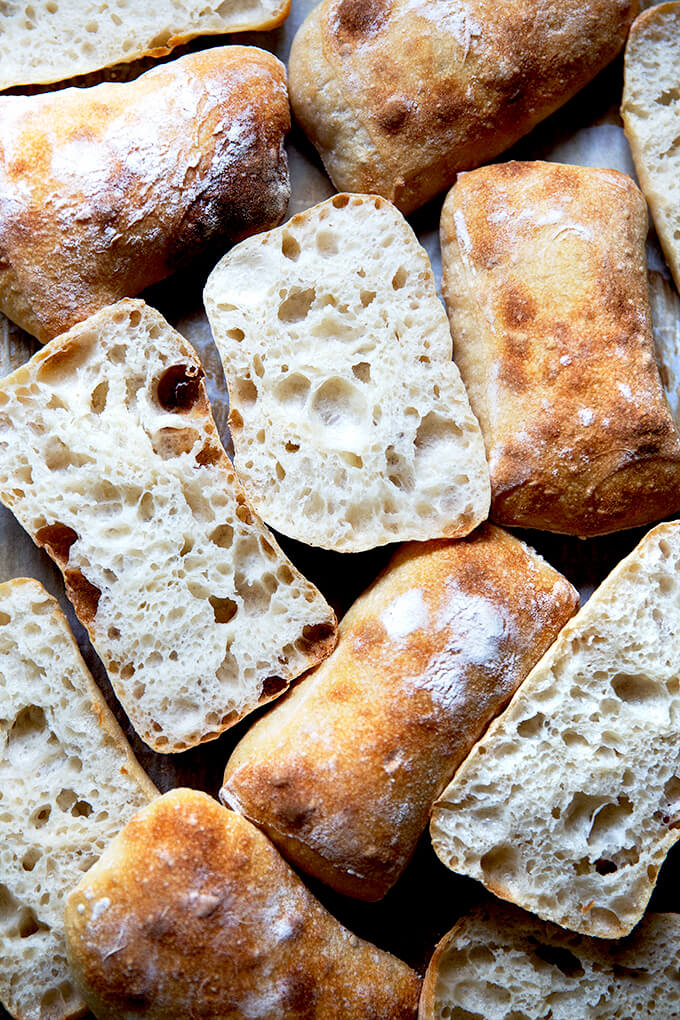
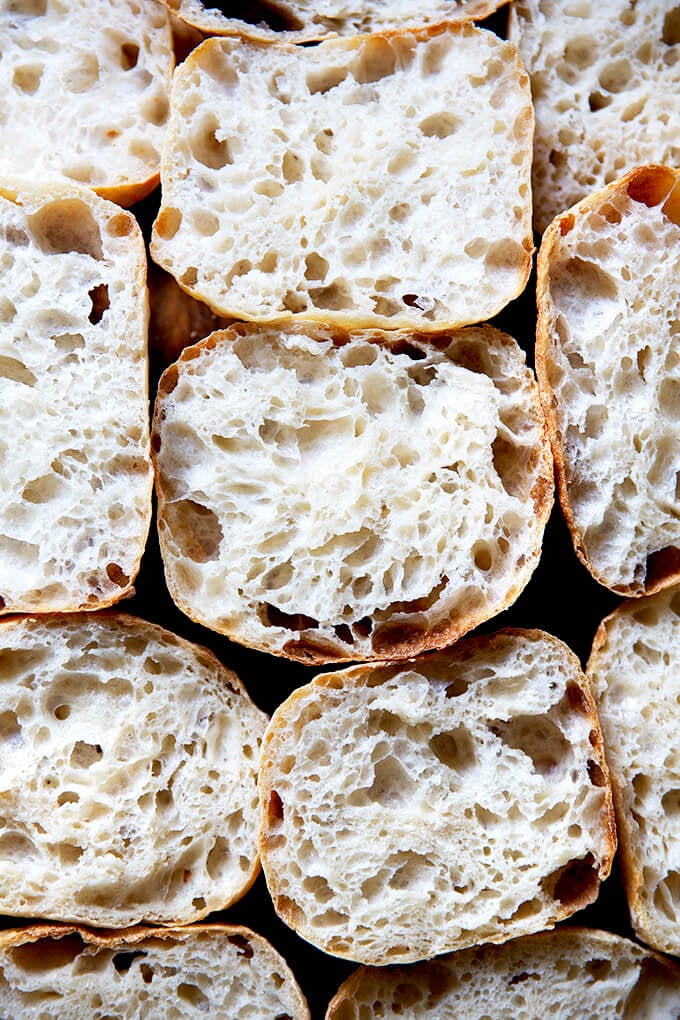
Ciabatta Sandwich
I have written about this favorite sandwich before, so forgive me if you know the story. It comes from Gabrielle Hamilton’s Blood, Bones, and Butter, a favorite book, and it’s something Gabrielle’s ex-husband, Michele, made for her during their courtship. If you have the book, the story is on page 163.
In short, the success of the sandwich relies on a delicate balance: “the perfection of three fats together — butter, olive oil, and the white fat from prosciutto or lardo.” To make it, spread good bread with “cool waxy butter,” top with prosciutto (more than you think), and arugula. Drizzle it all with good olive oil.
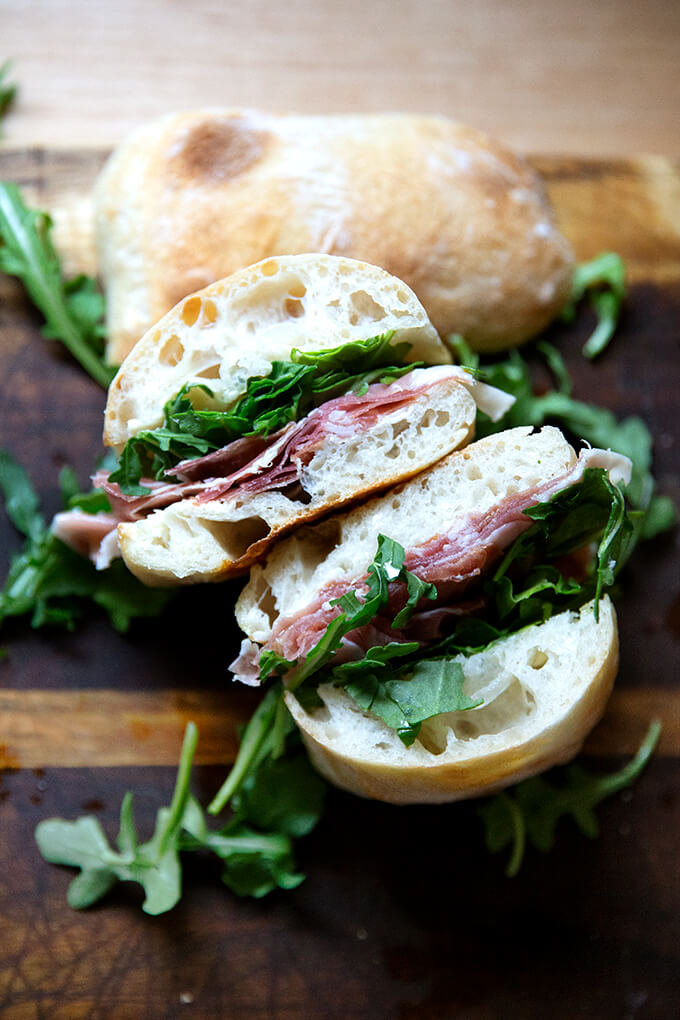
Sourdough Ciabatta “Baguettes” 🥖🥖🥖
To make baguettes, follow the same process, but instead of dividing the rectangle of dough into 8 portions, divide it into two. I find an extra-large sheet pan to be necessary to bake both baguettes at the same time. If you don’t have an extra-large sheet pan, I would bake one baguette at a time, and orient it at a diagonal angle from one corner to another.
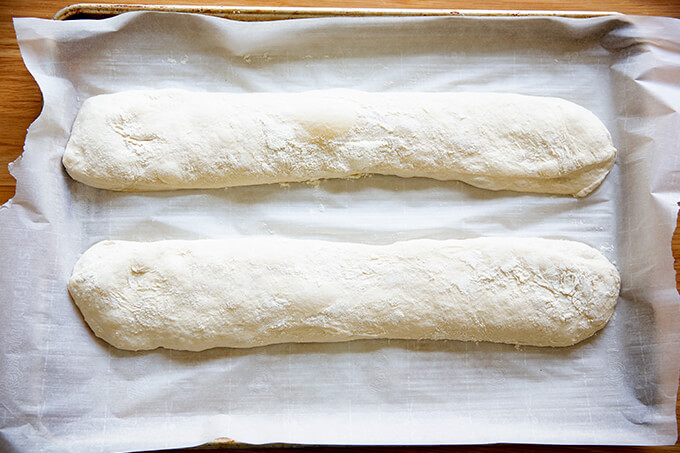
Bake the baguettes at the same temperature and for the same amount of time as the rolls.
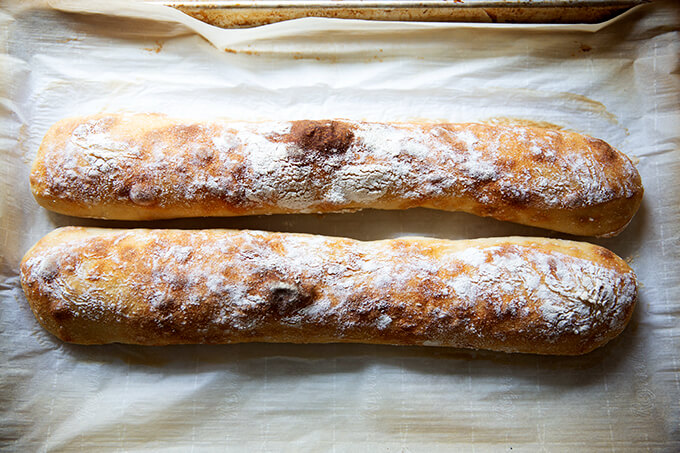
Not bad for the effort, right?
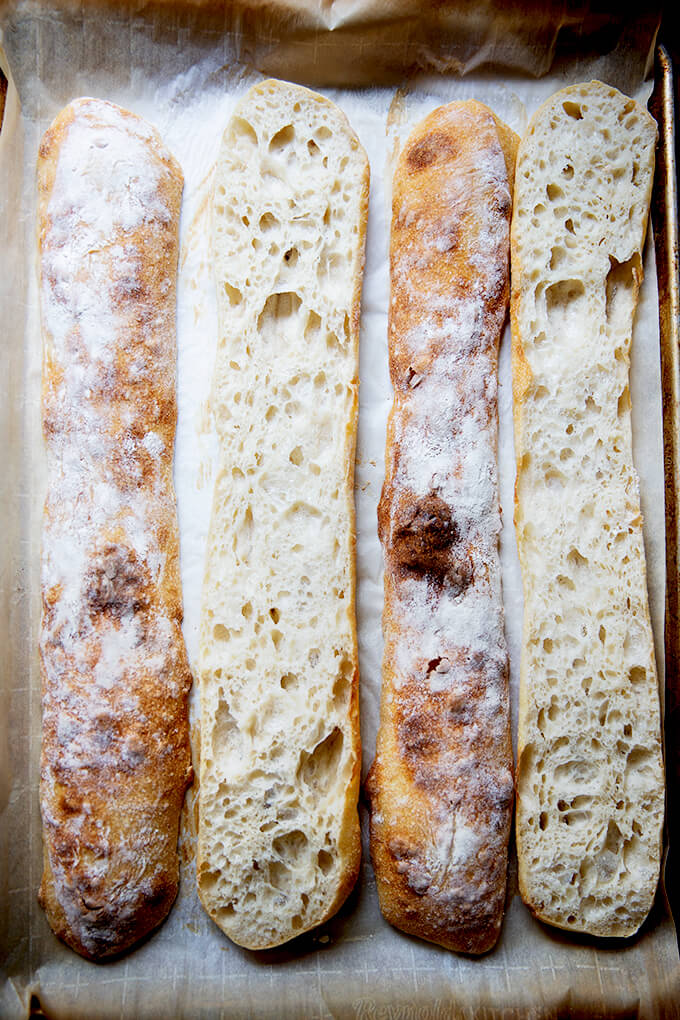
These ciabatta “baguettes” would be great vessels for giant sandwiches. I’ve been craving Bahn mi since
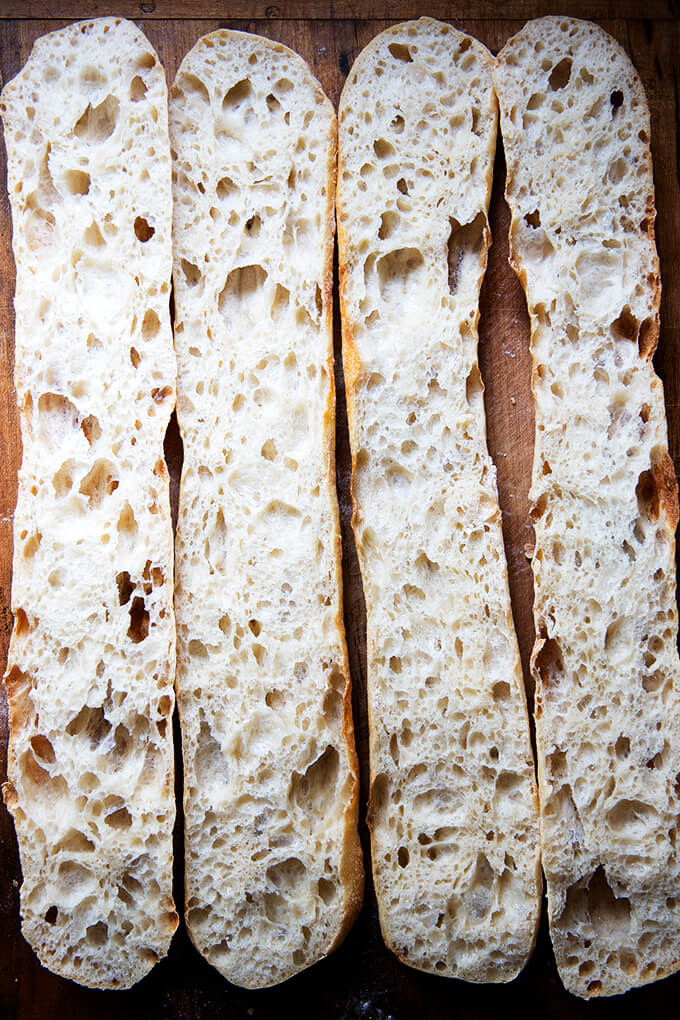
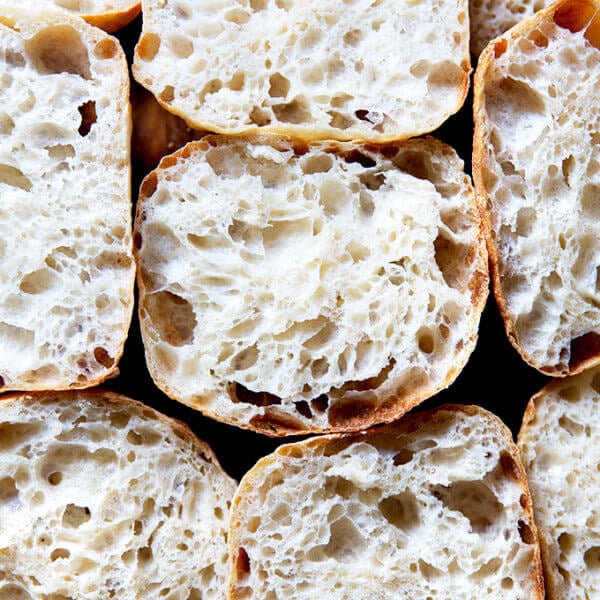
Simple Sourdough Ciabatta Bread
- Total Time: 24 hours 20 minutes
- Yield: 8 Rolls
- Diet: Vegan
Description
Notes:
- You need an active sourdough starter. You can build a starter from scratch in just about 1 week. But I am a huge proponent of buying a starter. Here are two sources:
- As always, I highly recommend investing in a digital scale before beginning any bread baking adventure.
Flour: I have had success using all-purpose flour, but if you can get your hands on bread flour, that is ideal, especially if you live in Canada or abroad. Moreover, if you live in Canada or abroad, you may need to reduce the water amount. Consider holding back some of the water during the mixing process to ensure you don’t end up with a soupy mess.
Straight-Sided Vessel:
- The vessel I use in this recipe, similar to this one, is 8 cups. Most grocery stores carry storage vessels similarly sized.
- Using a straight-sided vessel for the bulk fermentation will help prevent over-fermentation because it allows you to see when the dough has truly increased by 75% (or slightly more or less) in volume.
Ingredients
- 360 grams (about 1.5 cups) water
- 12 grams (about 2 teaspoons) salt
- 100 grams (about 1/2 cup) active sourdough starter, see notes above
- 450 grams (about 3.5 cups) bread flour, see notes above
Instructions
- Mix the dough: Place the water in a large bowl. Add the salt and stir briefly. Add the starter and stir briefly to incorporate. Add the flour, and stir until you have a wet, sticky dough ball. Knead briefly with your hands if necessary to incorporate the flour. Cover with a tea towel or cloth bowl cover and let sit for 30 minutes.
- Stretches and folds: With wet hands, grab one side of the dough, and pull up and to the center. Rotate the bowl a quarter turn, and repeat the grabbing and pulling. Do this until you’ve made a full circle. (Watch the video for more guidance. I do a few more pulls and turns in the video.) Cover the bowl. Repeat this process three more times at 30-minute intervals for a total of 4 sets of stretches and folds over the course of two hours. (In the video, I switch to coil folds for the last two sets of stretches and folds.)
- Bulk fermentation: Transfer the dough to a straight-sided vessel. Cover the vessel with a towel. Let rise at room temperature until the dough nearly doubles in volume (shoot for a 75% increase in volume). Times will vary depending on your environment and the strength of your starter. Recently, this has taken about 4 hours for me, but don’t worry if it takes longer for you. Cover vessel with a lid (ideally) or a towel (if you are using a towel, slick the top of the dough with oil to prevent it from drying out.) Transfer to fridge for 12-24 hours.
- Shape: Remove vessel from fridge. Remove lid. Sprinkle top of dough liberally with flour. Turn dough out onto a floured work surface. Pat dough into a rectangle. Sprinkle top with flour. Use a bench scraper to cut the dough in half vertically. Then make three cuts equally spaced in each half to create 8 small rectangles.
- Line a sheet pan with parchment paper. With floured hands, transfer each rectangle to the prepared pan, gently pulling outward. Cover the pan with a towel. Let stand for one hour.
- Bake: Heat oven to 475ºF. Transfer pan to oven and bake for 10 minutes. Lower heat to 450ºF, rotate pan, and bake for 10 minutes more. Remove pan from oven. Transfer ciabatta rolls to a cooling rack. Let cool for 20 to 30 minutes before slicing.
- Prep Time: 24 hours
- Cook Time: 20 minutes
- Category: Bread
- Method: Oven
- Cuisine: American, Italian
This post may contain affiliate links. Please read my disclosure policy.

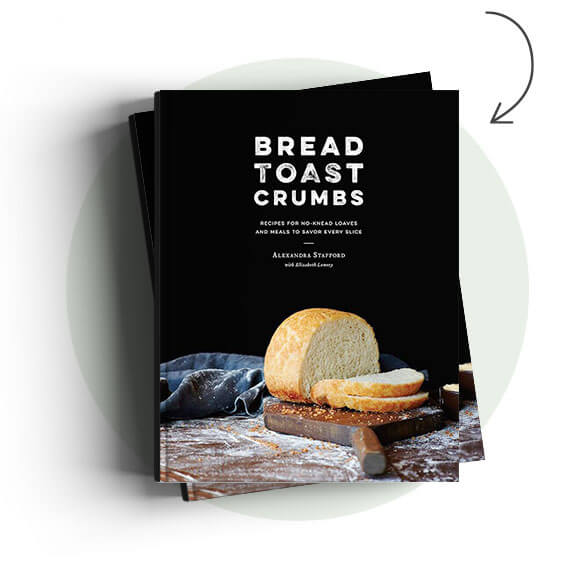



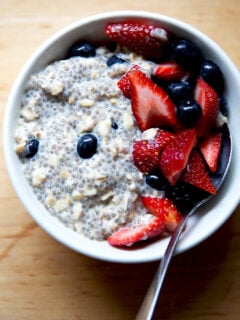
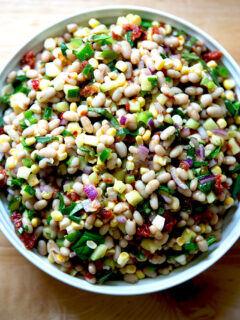
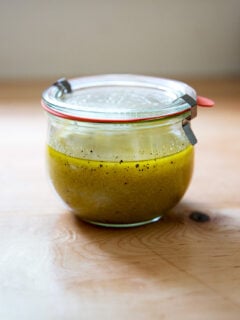



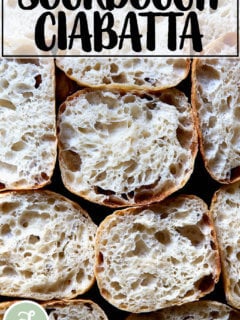
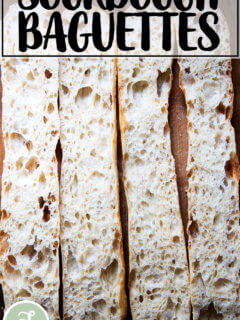
502 Comments on “Simple Sourdough Ciabatta Bread”
Amazing recipe and great video! They turn out perfectly every time, thank you!
Great to hear, Ness! Thanks for writing 🙂 🙂 🙂
Messed up the recipe, but… still good. Only used 50 g of starter (rye starter) that I fed 2 days prior. I only did a bulk ferment as my house is cold when I sleep (60°) and at work for about 22 hours. Probably should have baked them 3-5 more minutes, internal temperature was 205°. I did add some ice on a pan below for some steam. Definitely going to make again! ❤️ Loving my sourdough. Thank you for the recipe. Tagged you on FB and Instagram.
So nice to read all of this, Heidi! And apologies for the delay here, but it sounds as though you have a good handle on the whole process. I’ll try to find the tag on IG. Thanks!
Why do you suggest finding bread flour if in Canada? Canadian AP flour has high protein content equivalent to bread flour in the US. Canadian bread flour is higher yet in protein.
Hi David,
It has to do with how the flour absorbs water. Over the years I have troubleshooted with many people in Canada (and the UK), and the solution for dough that has been too wet and tricky to work with — my doughs are often very high hydration — has been to use bread flour as opposed to AP flour OR to reduce the water significantly. That said, some Canadians have written in and said that using AP flour works just fine. I think it all depends on the brand you are using — some flours just don’t absorb the water as well, which leads to very wet doughs.
Hope that helps!
Ali
Beautiful! The first time I did this, I don’t think my starter was strong enough. This time around, it came out way better. Outside of the fact that I struggle with my oven temp (got an oven thermometer to help fix), I did nearly everything else as instructed and the texture was airy with a great (although somewhat burnt no thanks to my oven) crumb. Steps were easy to follow. Will definitely do this again!
Do you have any nutrition info on this?
Great to hear, Nari! Glad you were able to make it work despite the oven issues. I don’t have the nutrition info, but this site is great for that: https://www.verywellfit.com/recipe-nutrition-analyzer-4157076
Another fantastic sourdough recipe with easy to follow instructions! These turned out great. I’m so impressed with myself. Haha. Thank you, Ali!
Hi Ali,
I’ve just started to make sourdough. Got the strong stater given and enjoy the feeding and observations.
Meanwhile, my sourdough ciabatta is with great texture but the crust can be improved to be less hard. Any tricks to improve the crust a bit? It is all good but I think there is a bit of room to improve. Some recipe is with water or ice on the tray at the bottom and some said to spray water mist to the oven while baking. Any opinion on this?
My sourdough faccacia seems working well but in general its a bit more sour than I want. Still very nice to eat but I would like to reduce the sourness a bit if it is possible. Any thoughts?
Im getting better and try not to waste too much flour. 🙂 Thank you so much for your great recipes and guidance to build confidence for the readers. Apologies for bombarding with questions.
Your loyal fan,
Wandee
Hi Wandee! Great to hear from you 🙂 Thank you for your kind words.
You can definitely try spraying the loaves with water before baking or using ice… I have to be honest, I haven’t tried either, so I don’t know what the affect will be.
Regarding the sourness of the focaccia, try feeding your starter more regularly — this will build its strength and allow it to rise more quickly, which will make for a less sour taste. And the stronger your starter is, the faster your focaccia will rise, which will also help minimize the sourness.
Hello! I don’t have a lot of experience (yet!) can I let the dough bulk ferment in the fridge for more than 24 hours? My 24 hours would be at 4am because I’m terrible with timing bread and my house is cold 🙃 can’t wait to see how it turns out! – Nicole
Nicole, yes! But you do need to let it bulk at room temperature for some time, too. In other words: use the fridge as needed but you do need allow the dough to rise to 50-75% in volume, which will only really happen at room temp. Do you have a straight-sided vessel?
Delicious and very easy to make, next time the only change would be to lightly coat the tub with olive oil as I had trouble releasing it from the container.
Great to hear, Anne, and great, tip, too. Thanks for writing!
Amazing recipe! This is the best bread that I have ever made I’m so happy with how it turned out. My dad is a tough critic and he is in love with this bread and wants me to make 3 more batches pronto. It is so so soft, the flavor is out of this world, and the crispiness of the crust is perfect. I’m keeping this recipe foreverr thank you!
Great to hear, Kyra! Thanks so much for writing and sharing all of this 🙂
I made this a while ago and it worked. Just tried again and the dough was way toooo hydrated. I was thinking I didn’t add enough flour. So I made it again and yep, way too hydrated. Not sure what I was doing wrong. I don’t get the dough ball seen in the pictures. When I tried to cut it and place it on the tray, there no shape… help
Hi! Are you using a scale to measure?
Yes I measured everything using a scale.
OK, where are you located: the US? or abroad? Humid environment? And what kind of flour did you use?
This was my first attempt with sourdough & it was amazing! Love how these turned out. They are so good I might have to make them weekly, at the very least. Thanks for a great, easy to follow recipe.
Great to hear, Lee! Thanks so much for writing 🙂 🙂 🙂
I now prefer this over regular sourdough. No better bread for a sandwich!
Great to hear, Renee! Thanks for writing 🙂 🙂 🙂